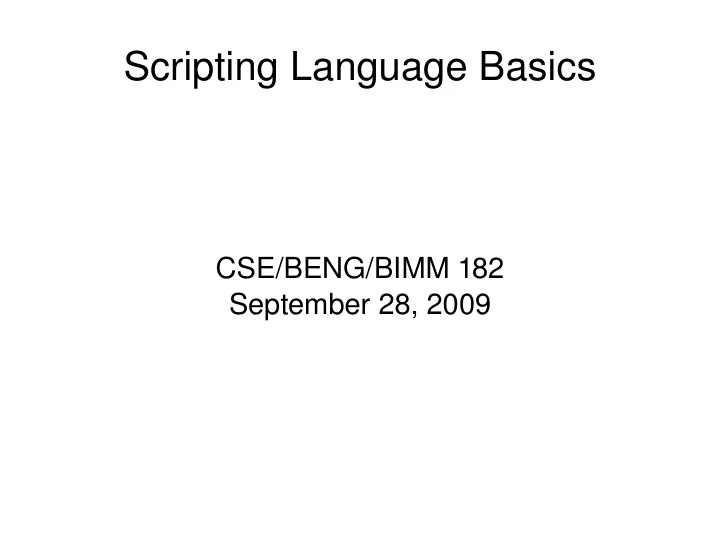

Scripting Language Basics CSE/BENG/BIMM 182 September 28, 2009
Scripting Languages ● Examples: Perl (Documentation: http://www.perl.org/docs.html) and Python (Documentation: http://docs.python.org/) ● Advantages: ● Easy to code ● Tons of prewritten scripts/modules developed for the bioinformatics community (e.g. BioPerl & BioPython) ● Not required for this class, but they are convenient for many applications discussed ● The best way to learn any language is to write some small scripts in it
Perl Basics: Command Line Input ● To invoke a Perl script from command line, type the following: perl PATH/FILE_NAME [ARG1 ARG2 …] ● ARGs are optional parameters which are fed as an array of inputs into the program (more later)
Perl Basics: Syntax and Headers ● All variables should start with identifiers ● $ for scalars ● @ for arrays ● % for hashes ● All lines should end with a semicolon (;) ● A script should begin with: #!PATH where PATH is the location of the Perl interpreter files – This is usually /usr/bin/perl ● To use premade modules, type use MODULE_NAME
Perl Basics: Variables ● Variables can be assigned values using the assignment operator (=) ● $i = 3; ● $j = 4; ● $str = “This is a Perl string”; ● Standard operations can be performed on integers ● $k = $i + $j; #$k = 7
Perl Basics: Strings ● Single quotes mean string is taken literally, double quotes mean string is interpreted ● Useful functions ● Size – length($str) ● Substring – substr($str, 3, 5)#takes the substring starting at index 3 with length 5 ● Concatenation – $str = "con"."cat".”enate”; #$str = “concatenate” ● Splitting a string up – my @line = split(/a/, $str);#@line is an array containing 3 parts: “conc”, “ten”, and “te” – Any regular expression can fit in between the slashes in the split function
Perl Basics: Arrays ● Can be instantiated during use ● Array labeled with '@', while elements in the array labeled with '$' (e.g. $row_line[$0] is the 1st element in @ row_line , which is “conc”) ● Maximum Index: $#array ● Size: scalar(@array)
Perl Basics: Conditionals and Loops ● Conditional: ● For Loops: for($i = 1; $i <= $size; if(BOOLEAN){ $i++){ STATEMENTS; print “$i\n”; } } elsif(BOOLEAN){ OR STATEMENTS; for $i (1 .. $size){ } print “$i\n”; else{ } STATEMENTS; Other types of loops } occur too (e.g. while)
Perl Basics: File I/O ● To open a stream: open(F0, STRING_LOCATION); ● Start the STRING_LOCATION with '>' for write/overwrite, '>>' for write/append, or '<' for read (default – if nothing is placed before the file name) ● To read all at once into an array: my(@lines) = <F0>; ● To read line-by-line: ● while(<F0>){ $line = $_; chomp($line); #Process as required print “$line\n”; } ● To write to a file, simply insert the stream between print and the text (e.g. print F1 “$line\n”; #F1 is a write stream opened similarly to above)
Called from command line with: Sample Script perl ./PerlTest.pl TestArraySizes.txt
Python Basics: Syntax and Headers ● Spacing is important – off by one can throw off the whole program ● Should begin with: #!<PATH> where <PATH> is the location of the Python interpreter files (usually /usr/bin/env python ) ● To use premade modules, type import <MODULE_NAME>
Python Basics: Command Line Input ● To invoke a Python script from command line, type the following: python <PATH/FILE_NAME> [ARG1 ARG2 …] ● ARGs are optional parameters which are fed as an array of inputs into the program (more later)
Python Basics: Variables ● Variables can be assigned values using the assignment operator (=) ● i = 3 ● j = k = 4 ● str = “This is a Python string” ● Standard operations can be performed on integers ● l = i + j; #l = 7
Python Basics: Strings ● Immutable (can't be changed directly, but can be modified and stored) ● Useful functions ● Size – len(str) ● Substring – str[3:7] #takes the substring starting at index 3 with length 5 ● Concatenation – str = "con" + "cat" + ”enate” #str = “concatenate” ● Splitting a string up – line = str.split(“a”);#line is an array containing 3 parts: “conc”, “ten”, and “te”
Python Basics: Arrays ● Should be instantiated prior to usage ● Access: array[i] is the ith element in array ● Size: len(array)
Python Basics: Conditionals and Loops ● Conditional: ● For Loops: if(BOOLEAN): for i in range(1, size): STATEMENTS print '%d' % i ● Other types of loops elif(BOOLEAN): STATEMENTS occur too (e.g. while) else: STATEMENTS
Python Basics: File I/O ● To open a stream: F0 = open(STRING_LOCATION) ● Have a second parameter with 'w' for write/overwrite, 'a' for write/append, or 'r' for read (default – if nothing is placed before the file name) ● To read all at once into an array: lines = F0.readlines() ● To read line-by-line: ● line = F0.readline() ● for line in F0: #Process as required print line ● To write to a file, print >>F1 “line” #F1 is a write stream opened similarly to above OR ● F1.write(“line”)
Called from command line with: python ./PythonTest.pl TestArraySizes.txt Sample Script
Questions?
Recommend
More recommend